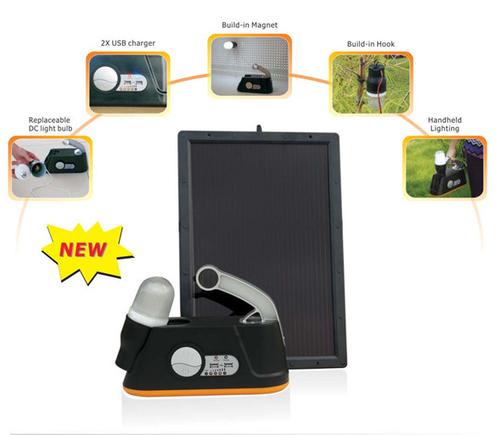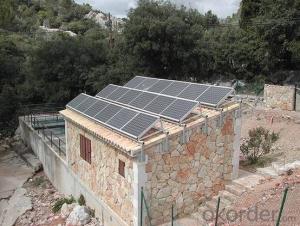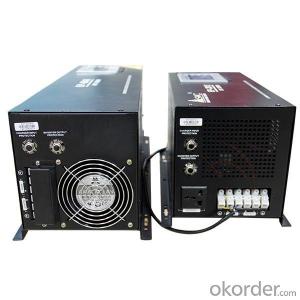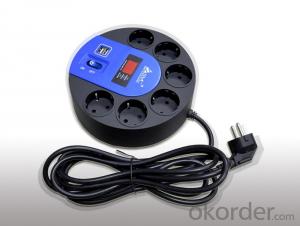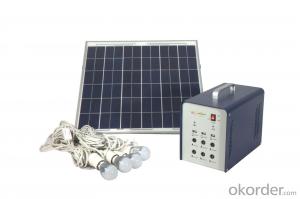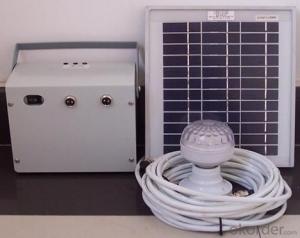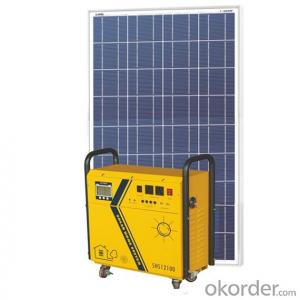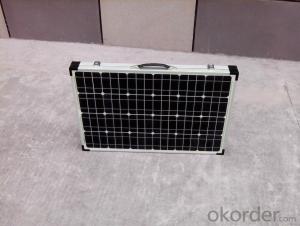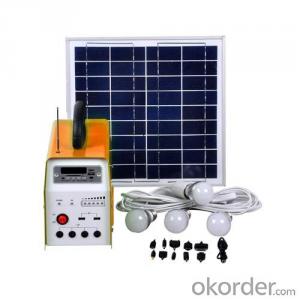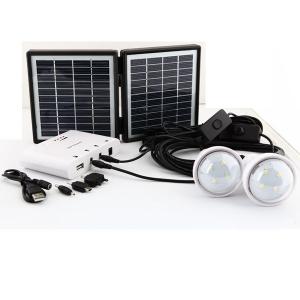Solar Energy Systems Nappanee - Solar Portable Power Kit 6W (TPS-201)
- Loading Port:
- China Main Port
- Payment Terms:
- TT or LC
- Min Order Qty:
- -
- Supply Capability:
- 50000sets m.t./month
OKorder Service Pledge
OKorder Financial Service
You Might Also Like
Product DescriptionDescription: TPS-201 6W Solar Portable Power Kit 1.Solar portable lighting kit for both indoor and outdoor use. Good for sheds, garage, camping 2.Replaceable energy saving/LED bulb provide bright lighting 3.Built-in magnet & hanging hook enables easy fixing of the bulb 4.USB output available to power mobile phones & other electronic devices alike 5.User friendly indicator for easy monitoring of the battery status. 6. 6W Amorphous solar panel + 12V/4.5AH Battery + one pcs 5W lighting with 3M cables + 2 pcs USB output (charging mobile phone) + Voltage indicater |
- Q: Can solar energy systems be used for powering electric vehicle solar charging canopies?
- Yes, solar energy systems can be used to power electric vehicle solar charging canopies. Solar panels installed on the canopies can generate electricity from the sun, which can then be used to charge electric vehicles. This sustainable approach reduces reliance on traditional power sources and helps promote clean energy solutions.
- Q: Can solar energy be used for industrial processes?
- Yes, solar energy can be used for industrial processes. It is a versatile and sustainable source of power that can be harnessed for various industrial applications, such as heating, cooling, and electricity generation. By utilizing solar technologies like solar thermal systems and photovoltaic panels, industries can reduce their reliance on fossil fuels and lower their carbon footprint. Additionally, solar energy can provide a reliable and cost-effective solution for meeting the energy demands of industrial processes.
- Q: Can solar energy systems be used in powering fire stations or police stations?
- Yes, solar energy systems can be used to power fire stations or police stations. Solar energy is a renewable and sustainable source of power that can provide a reliable and cost-effective solution for these facilities. Fire stations and police stations typically require a consistent and uninterrupted power supply for lighting, communications, security systems, and other essential equipment. Solar panels can be installed on the rooftops or in nearby areas to harness sunlight and convert it into electricity. This electricity can then be used to power the various electrical systems within these facilities. By using solar energy, fire stations and police stations can reduce their reliance on traditional grid electricity, lower their operational costs, and contribute to a greener environment. Additionally, solar energy systems can also include battery storage to store excess electricity generated during the day, ensuring a continuous power supply even during nighttime or periods of low sunlight. Overall, solar energy systems are a viable and practical option for powering fire stations and police stations, promoting energy independence and sustainability for these crucial public service institutions.
- Q: Can solar energy systems be used for powering off-grid telecommunications networks?
- Yes, solar energy systems can be used for powering off-grid telecommunications networks. Solar panels can generate electricity from sunlight, which can be stored in batteries for later use. This stored energy can then be used to power telecommunication equipment such as cell towers, antennas, and communication devices, ensuring reliable and sustainable power supply in remote areas or during power outages.
- Q: Can solar energy systems be used for powering off-grid eco-retreats?
- Yes, solar energy systems can definitely be used for powering off-grid eco-retreats. Solar panels can harvest energy from the sun and convert it into electricity, providing a sustainable and renewable source of power. This makes solar energy an ideal choice for off-grid locations, where accessing traditional power sources may be challenging or expensive. By installing solar panels and a battery storage system, off-grid eco-retreats can enjoy a reliable and clean energy source, reducing their carbon footprint and promoting sustainability.
- Q: Can solar energy systems be used in cloudy or rainy areas?
- Yes, solar energy systems can still be used in cloudy or rainy areas. While solar panels do produce less electricity in cloudy or rainy conditions compared to sunny conditions, they can still generate power. Additionally, advancements in solar technology have made panels more efficient in low-light conditions, allowing them to harness energy even in cloudy or rainy areas.
- Q: How does the size of solar panels impact energy production?
- Energy production is directly affected by the size of solar panels, as it dictates the quantity of sunlight that can be captured and transformed into electricity. Solar panels of larger dimensions possess a greater surface area, enabling them to absorb a larger amount of sunlight and generate a higher electricity output. Consequently, larger panels have the capability to produce more energy in comparison to smaller ones. Moreover, larger panels can accommodate a greater number of solar cells, thereby further augmenting their energy production capacity. Nevertheless, it is crucial to consider the available space, cost, and specific energy requirements when determining the appropriate size of solar panels.
- Q: How does the efficiency of solar panels vary across different installation locations?
- The efficiency of solar panels varies across different installation locations due to various factors such as the amount of sunlight received, the angle and orientation of the panels, shading, temperature, and local weather conditions.
- Q: Can solar energy systems be installed in any location?
- Solar energy systems can be installed in most locations, as long as there is sufficient sunlight available. However, the efficiency and effectiveness of the system may vary depending on factors such as the amount of sunlight, shading, and the available roof or ground space for installation.
- Q: Are there any government grants or funding options for solar energy systems?
- Yes, there are government grants and funding options available for solar energy systems. Many governments around the world offer financial incentives, such as grants, tax credits, and rebates, to encourage the adoption of solar energy. These programs aim to support the transition to clean and renewable energy sources, reduce greenhouse gas emissions, and promote sustainable development. Additionally, some governments provide low-interest loans or financing programs specifically tailored for solar projects. It is advisable to check with local government agencies or energy departments to obtain detailed information on the available grants and funding options in a specific region.
1. Manufacturer Overview
| Location | Shenzhen,China |
| Year Established | 2002 |
| Annual Output Value | Above US$80 Million |
| Main Markets | Europe, North America, Africa and Asia. |
| Company Certifications |
2. Manufacturer Certificates
| a) Certification Name | |
| Range | |
| Reference | |
| Validity Period |
3. Manufacturer Capability
| a) Trade Capacity | |
| Nearest Port | Shenzhen shekou |
| Export Percentage | 90% |
| No.of Employees in Trade Department | 200-300People |
| Language Spoken: | English;Chinese; |
| b) Factory Information | |
| Factory Size: | Above 300,000 square meters |
| No. of Production Lines | Above 10 |
| Contract Manufacturing | OEM Service Offered;Design Service Offered |
| Product Price Range | Average |
Send your message to us
Solar Energy Systems Nappanee - Solar Portable Power Kit 6W (TPS-201)
- Loading Port:
- China Main Port
- Payment Terms:
- TT or LC
- Min Order Qty:
- -
- Supply Capability:
- 50000sets m.t./month
OKorder Service Pledge
OKorder Financial Service
Similar products
Hot products
Hot Searches
Related keywords

